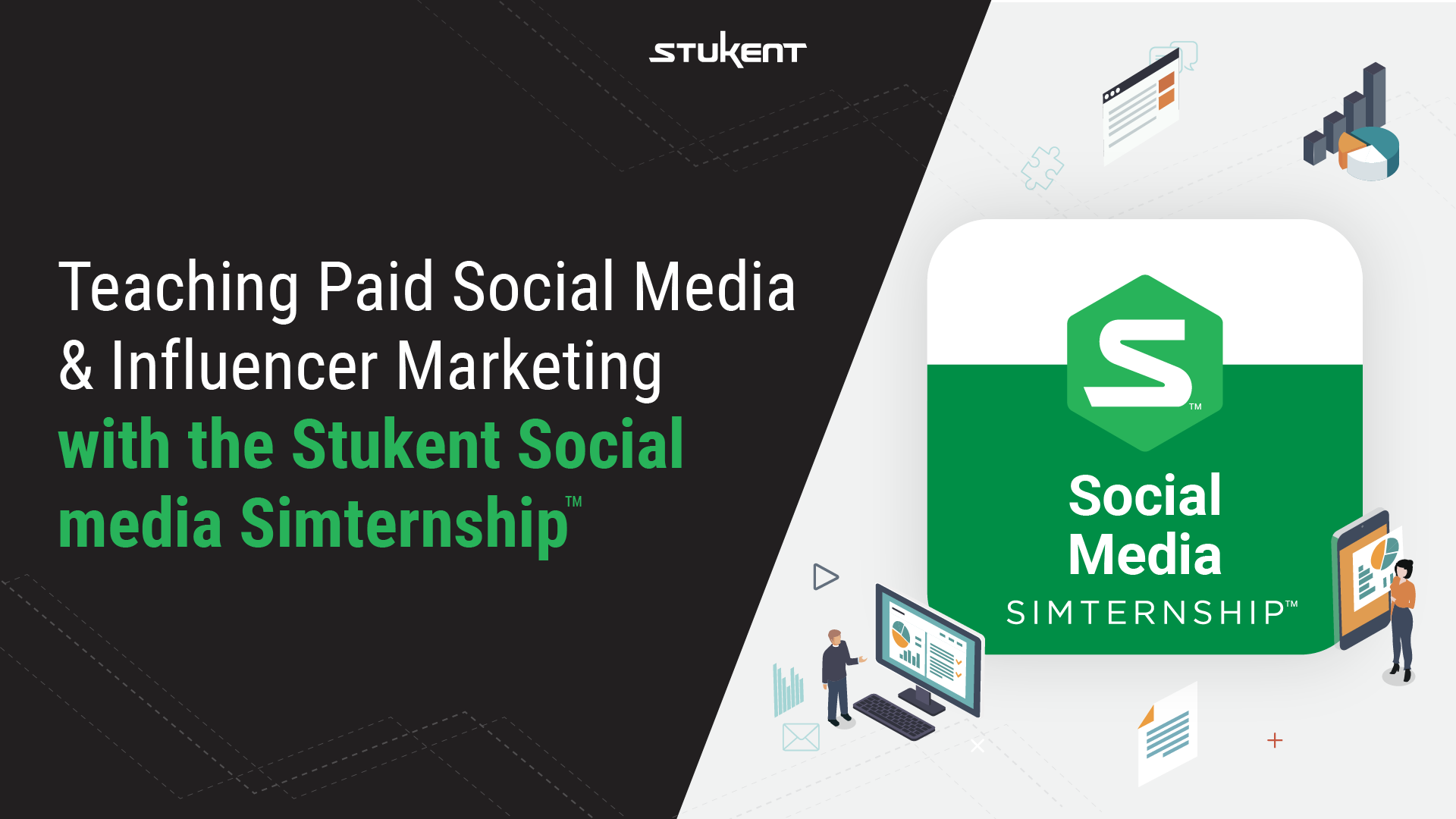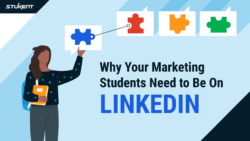This is Post 1 in a two-part series about teaching paid social media with the Stukent Social Media Simternship™. After reading this post, see Post 2 on my blog, MattKushin.com. In that post I discuss how I implemented the simulation in my class, and I provide a Stukent Social Media Simternship™ assignment.
I’ve taught a number of social media classes since the 2010-2011 academic year. In that time, I have employed countless activities and assignments with one goal in mind: preparing my students for careers in an ever-changing media field.
Organic social media dominated the early years of social media, and thus social media education. But in recent years, paid social has become a prominent feature in any social media strategy. That’s why we must teach paid social media to our students. But how do we do so effectively?
One option is to find a class client that can provide your students a budget to spend on paid social media advertising. As you might imagine, finding such a class client can be challenging. Another option is to use a social media simulation such as Stukent’s Social Media Simternship to allow students experience working with a budget without the real-world strings attached. In my Fall 2020 social media class, I did just that.
Background
Stukent simulations provide hands-on learning experiences in virtualized environments, covering a growing range of topics from personal finance to business analytics.
I first got to know Stukent’s simulations through my exploration of Stukent’s Intro to Business Simternship™, a pay-per-click search engine advertising simulation. I used the simulation for several semesters in my “Writing Across Platforms” class at Shepherd University. That class that aims to teach students a variety of promotional writing styles across the PESO model. As I wrote about on my blog, the Stukent Intro to Business Simternship™ introduced my students to writing search engine ads in an engaging, competitive environment.
Student feedback was positive, I liked the hands-on nature of the assignment, and I liked how much of the assignment was self-contained, meaning students could do it at their own pace without too much intervention from me.
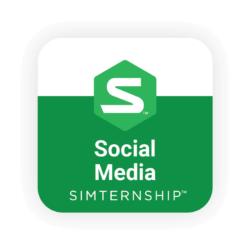
So, when the pandemic hit and I realized I would be teaching Fall 2020 courses entirely online, I thought the Stukent Social Media Simternship may offer some affordances for online learning.
Learning Goals
Here is a summary of the learning goals I had in mind when I considered using the simulation. With each, the objective was to enhance knowledge and allow students to gain hands-on experience with:
Scheduling Social Media Posts
Off and on over the last few years, I have had my social media students complete the Hootsuite University certification to gain knowledge about social media dashboards and post scheduling.
The Stukent Social Media Simternship offers a simulated social media dashboard that allows students to schedule their posts for different social platforms.
Social Media Optimization
Posting different types of content to different platforms at different dates and times can have an impact on content performance. Social media optimization — or, identifying what content performs best at what time on what platform — requires data to analyze. My students learn about this through social media analytics platforms in class.
But the Stukent simulation offered an additional opportunity for students to learn social media optimization by viewing simulated performance metrics.
Targeting Audiences on Social Media
A major factor in one’s success in the Stukent Social Media Simternship is the ability to understand the target audience and create content that will appeal to them on the social platforms they spend their time on.
Paid Social Media
As noted, it is a challenge to give students the opportunity to gain hands-on experience with paid social media.
Stukent’s Social Media Simternship challenges students to carefully employ a weekly budget to promote posts across a number of social media channels, with each post aimed at a target audience. The provided performance analytics allow students to experiment in a safe setting. Students learn from their successes and mistakes, make changes, and see how their adjustments affect revenue.
Influencer Marketing
The rise of influencer marketing in the last few years is something we cannot ignore. But like paid social media, influencer relations is difficult to teach in a hands-on manner in the classroom. I’ve taught about digital influence in a variety of ways over the years, including using Hootsuite and with this fun activity.
In Stukent’s Social Media Simternship, students must learn to navigate the world of social media influencers — from mega stars with millions of followers to micro influencers with targeted niches.
How Stukent’s Social Media Simternship™ Works
In the simulation, students work on behalf of the hypothetical company Buhi Supply Co. to sell a product line (which consists of a variety of stylish bags at different price points) to pre-defined audiences across social media platforms such as Facebook, Instagram, LinkedIn, and Pinterest.

Organization
The simulation works in paired rounds. In the odd-numbered rounds, students set up social media posts for different social platforms, decide which posts they want to pay to boost, and then run the simulation. The even-numbered rounds are analysis rounds; students see their results and are prompted with a series of questions to answer (more on that below). Combined, two rounds comprise one week.
At the beginning of the simulation, students are given an executive summary about Buhi Supply Co., an overview of products, audience personas, existing analytics of Buhi’s social media efforts, a budget, and goals. Goals include using the budget wisely, growing brand awareness, increasing engagement, increasing sales, and outperforming one’s peers. Because Stukent does not provide an overall specific dollar amount that students are to achieve, I provided my students with a goal of $300,000 in revenue across the course of the simulation experience.
Before each round, students receive a “weekly memo” from the CMO of Buhi. The memos provide context on what to work on for the round as well as links to articles aimed to help them succeed.
Decision-making
Student work includes choosing social media post text and imagery, picking the social platform the post is to be published on, and selecting the date and time the post is to be published.
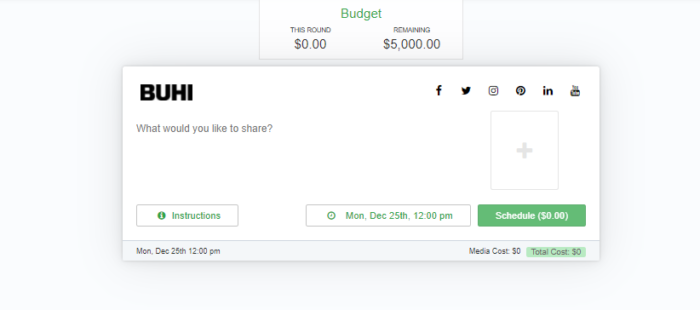
There are two ways students spend down their budget in the first several rounds of the simulation: 1) on multimedia and 2) on promoting posts. Different multimedia options — such as memes, photos, and video — have different prices.
In terms of promoting posts, students select their budget and assign the post to a target audience. That target audience can be saved so it can be targeted in future posts. The trick is to create targeted audiences that align with Buhi’s pre-defined audience personas from the target market research Buhi provides. Each audience persona makes up a different percent of the market, has an age range, income range, and interests.
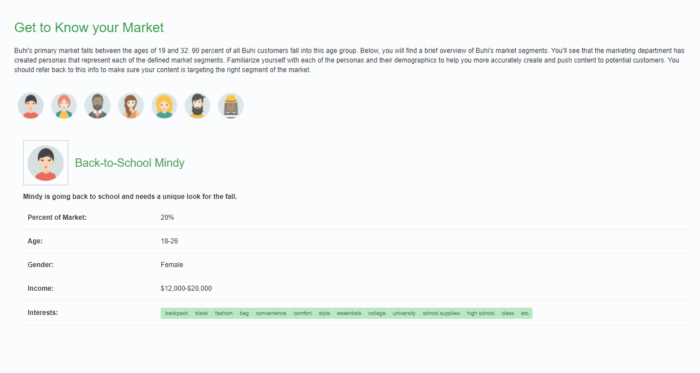
Once students have used up their weekly budget of $5,000 or created all of the posts they want to, they run the simulation. This brings students to Round 2 where they see four tabs: post analytics, post history, questions, and course rankings.
Feedback and Questions
The first tab is post analytics, which includes awareness, engagement, and revenue metrics. Post analytics also includes social media performance by day for each social platform they published to. The post history tab contains a list of each post they made and how it performed. The course ranking tab shows students how they rank compared to their peers. The questions tab contains a list of open-ended questions students can complete. However, they do not have to.
To move on to the next round, students must scroll to the bottom of the questions tab and click “Submit.” Answers typed into the text boxes are recorded and the instructor can see students’ answers. The simulation follows this pattern for odd and even rounds. When working on their posts, students can access their previous analytics to help them make numbers-driven decisions.
Additional Skills
As the old saying goes, “but wait, there’s more…”
The simulation goes beyond the crafting of targeted paid social media posts to specific audiences. The simulation teaches students other useful skills: social media customer service and influencer management.
Starting in round 5, students may receive messages from customers with questions. Students can choose a reply to help the customer. This simulates customer service inquiries on social media.
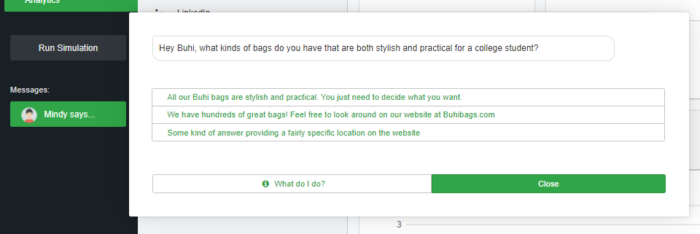
Influencers
Starting in Round 7, students begin working with influencers. Before students get started, they are given a brief introductory video and provided text information about working with influencers.
To me, this is one of the coolest parts of the simulation. As instructors, we talk a lot with our students about working with influencers. But where can they get real experience doing that?
In the simulation, there are three steps to working with influencers: 1) choose the influencer, 2) select the strategy, and 3) finalize the budget.
Just like IRL, the Stukent Social Media Simternship influencers have their own unique talents, platforms they excel on, and follower sizes. The goal is to match the right influencer with the right strategy at the right price to the right target audience.

But the influencers are a bit finicky. Students have to pitch a budget to an influencer. If the influencer likes it, they will do the work. If they don’t, there is a little room for negotiation before the influencer may get fed up and stop responding to a student’s requests. The challenge, then, is getting the influencer to do the work at the lowest price without being ghosted.
The weekly budget stays at $5,000 in the influencer rounds. Students have to juggle spending on influencer content with spending on posts.
After an influencer agrees to an offer, that influencer will post the promotional content when the simulation runs. From Round 8 on, students have two new tabs in their even-numbered rounds: 1) influencer analytics and 2) influencer history.
Refining Their Craft
Through repetition of the rounds and the accompanying analytics, students learn to refine their craft. The opportunities to experiment and tweak enable students to adjust their approach and learn by doing.
Looking Forward
The next post in this two-part series is published on MattKushin.com. In it, I talk about how I implemented the Stukent Social Media Simternship™ into my class. I also provide a copy of an assignment and explain my grading approach.
About Matt Kushin
Matthew J. Kushin, Ph.D. (@mjkushin) is an associate professor in the Department of Communication at Shepherd University. Matt is the author of Teach Social Media: A Plan for Creating a Course Your Students Will Love. He writes Social Media Syllabus (MattKushin.com), a blog and resource for social media educators. He was the Stukent Professor of the Month in November 2018.

